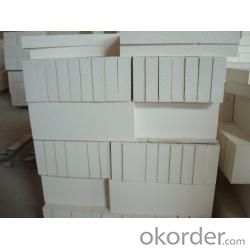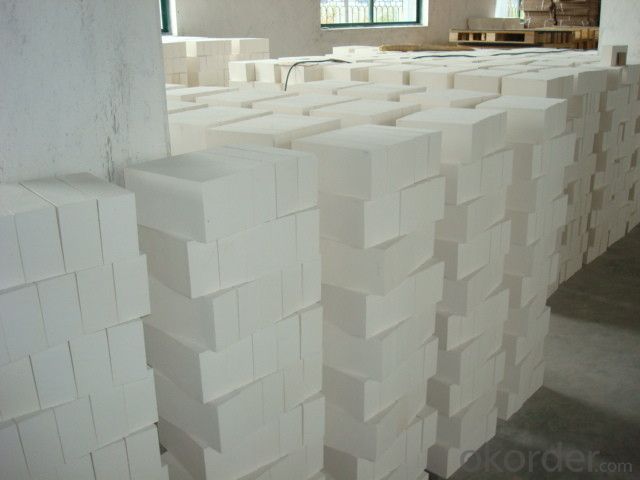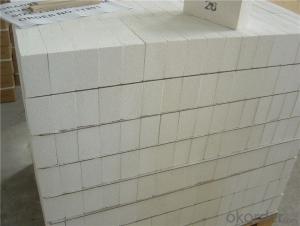Light weight fire clay for insulating fire brick
- Loading Port:
- Tianjin
- Payment Terms:
- TT OR LC
- Min Order Qty:
- 20 m.t.
- Supply Capability:
- 10000 m.t./month
OKorder Service Pledge
OKorder Financial Service
You Might Also Like
CNBM conforms strictly to the requirements of ISO 9000 quality control system during the production. MSDS is also available if you want. The thermal insulation fire clay brick meet with the requirements of ASTM & JIS standards. So pls stay cool with our quality.
Insulating Fire Brick Technical index
Product No. | IFB70 | IFB60 | IFB50 | IFB40 |
Al2O3 | 68%-72% | 58%-62% | 48%-52% | 38%-40% |
Refractoriness (°C ) | ≥1790 | ≥1790 | ≥1790 | ≥1790 |
Bulk density (g/cm3) | 2.50-2.60 | 2.35-2.45 | 2.20-2.30 | 2.10-2.20 |
Apparent porosity (%) | 22 | 19-22 | 17-20 | 17-20 |
Cold Crushing strength (kg) | 480-510 | 450-480 | 430-450 | 390-430 |
Application
Insulating Fire Brick are used for the lining of converter, alternating current arc furnace, direct Current arc furnace and the ladle slag line, etc.
Equipment
1 unit of Ceramic Abrasive (SG Abrasive) pilot production line
2 units of Compact grain Abrasive pilot production lines
1 unit of high-end coated abrasives (abrasive cloth) production line
2 units of Boron Carbide production lines
3 large flexible crushing and sieving lines for grit production lines
2 units of 2000KVA furnaces for Boron Carbide fusion
6 units of 5000KVA-10000KVA dumping type electric arc furnaces for Brown Fused Alumina fusion
Company Advantage
(1)Long Insulating Fire Brick manufacture history: 25 years manufacturer
(2)Advanced equipment
(3)Diversification of production standards: ISO ANSI FEPA JIS ASTM
(4)Flexible payment: T/T L/C D/P D/A
(5)Professional marketing team and after-sale service
(6)Free sample


- Q:Are insulating fire bricks resistant to water penetration?
- Insulating fire bricks exhibit resistance to water penetration. These bricks possess a low porosity and are fabricated from materials that do not readily absorb or retain water. Typically, they consist of lightweight refractory materials like alumina, silica, and other minerals that possess remarkable heat resistance and minimal water absorption capabilities. Consequently, insulating fire bricks are highly suitable for scenarios where water penetration could be detrimental, such as in high-temperature environments or when utilized as insulation in chimneys or kilns. However, it is essential to acknowledge that while these bricks resist water penetration, they are not entirely impervious to it. Prolonged exposure to water may eventually result in some degree of water absorption, which can impact their insulating properties. Therefore, it is prudent to exercise caution and ensure proper installation and maintenance to optimize their resistance against water penetration.
- Q:Can insulating fire bricks be used in sewage treatment plants?
- Yes, insulating fire bricks can be used in sewage treatment plants. These bricks are designed to withstand high temperatures and provide insulation, making them suitable for various industrial applications, including sewage treatment plants where high temperatures may be present. Insulating fire bricks help to reduce heat loss and improve energy efficiency in these facilities.
- Q:Can insulating fire bricks be used in high-temperature insulation for cryogenic applications?
- Insulating fire bricks do not meet the requirements for high-temperature insulation in cryogenic applications. They are specifically designed to endure temperatures up to approximately 2300°F (1260°C), which falls significantly below the extremely low temperatures necessary for cryogenic applications. Cryogenic temperatures typically span from -150°C to -273°C (-238°F to -459°F), and insulating fire bricks lack the capability to offer sufficient insulation under these conditions. Instead, cryogenic insulation commonly relies on specialized materials like aerogels or multi-layered insulation systems to guarantee minimal heat transfer and sustain the extremely low temperatures demanded.
- Q:Can insulating fire bricks be used for insulation in refractory lining repair?
- Yes, insulating fire bricks can be used for insulation in refractory lining repair. Insulating fire bricks are specifically designed to provide insulation in high-temperature environments, making them suitable for repairing refractory linings that require thermal insulation.
- Q:How do insulating fire bricks perform in terms of sound insulation?
- Insulating fire bricks are primarily designed for excellent thermal insulation, but their performance in terms of sound insulation can vary. While they can provide some sound reduction due to their dense and non-porous nature, they are not specifically engineered for soundproofing. The level of sound insulation offered by insulating fire bricks depends on factors such as brick thickness, density, and sound frequency. Generally, insulating fire bricks can somewhat reduce high-frequency noises, but they may not be as effective in blocking low-frequency sounds. For superior sound insulation, specialized acoustic materials or construction techniques may be more appropriate.
- Q:Can insulating fire bricks be used as a lining for boilers?
- Indeed, boilers can make use of insulating fire bricks as linings. These bricks are specifically engineered to endure extreme temperatures and possess outstanding thermal insulation capabilities. Their prevalent application lies in contexts where conserving heat and promoting energy efficiency are paramount, notably in industrial boiler settings. The insulating properties inherent in these bricks facilitate the reduction of heat dissipation and enhance the overall efficiency of the boiler. Furthermore, their robustness and ability to withstand thermal shock render them fitting for deployment within boiler linings, where they can endure the harshest conditions and temperature fluctuations.
- Q:Do insulating fire bricks require any special tools for installation?
- No, insulating fire bricks do not require any special tools for installation. They can be easily installed using standard masonry tools such as a trowel and mortar.
- Q:Are insulating fire bricks suitable for use in chimneys and fireplaces?
- Yes, insulating fire bricks are suitable for use in chimneys and fireplaces. They have excellent thermal insulation properties, which helps to retain heat and prevent the transfer of excessive heat to the surrounding structure. This makes them a safe and efficient choice for lining chimneys and fireplaces, as they can withstand high temperatures and reduce the risk of heat damage.
- Q:Are insulating fire bricks resistant to salt attack?
- Yes, insulating fire bricks are generally resistant to salt attack. They have a high resistance to chemical reactions and can withstand exposure to salts without significant deterioration.
- Q:Can insulating fire bricks be used in chimney lining?
- Indeed, insulating fire bricks are a suitable option for chimney lining. These bricks are specifically engineered to endure extreme heat and offer exceptional insulation. Their ability to retain heat within the chimney prevents any loss through the walls, which ultimately enhances the efficiency of fireplaces or stoves. Moreover, their lightweight nature and straightforward installation process have contributed to their popularity in chimney lining projects. Nonetheless, it is crucial to verify that the chosen insulating fire brick meets the requirements for chimney applications and adheres to local building codes and regulations.
1. Manufacturer Overview |
|
|---|---|
| Location | |
| Year Established | |
| Annual Output Value | |
| Main Markets | |
| Company Certifications | |
2. Manufacturer Certificates |
|
|---|---|
| a) Certification Name | |
| Range | |
| Reference | |
| Validity Period | |
3. Manufacturer Capability |
|
|---|---|
| a)Trade Capacity | |
| Nearest Port | |
| Export Percentage | |
| No.of Employees in Trade Department | |
| Language Spoken: | |
| b)Factory Information | |
| Factory Size: | |
| No. of Production Lines | |
| Contract Manufacturing | |
| Product Price Range | |
Send your message to us
Light weight fire clay for insulating fire brick
- Loading Port:
- Tianjin
- Payment Terms:
- TT OR LC
- Min Order Qty:
- 20 m.t.
- Supply Capability:
- 10000 m.t./month
OKorder Service Pledge
OKorder Financial Service
Similar products
New products
Hot products
Related keywords



























